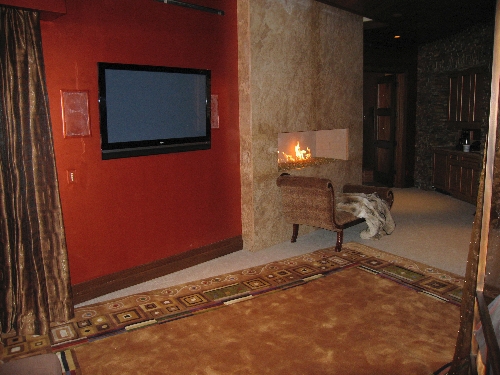Color, especially on walls, key component of design
If you were asked to name the key component of a room's design, the spark that makes it all come together and ignite into one glorious setting, what would you choose? The furniture, the floor and window coverings or maybe the fabrics? If you picked anyone of these, then you're overlooking one of the key elements in design: color.
It may very well be that the essence of a room, indeed the entire home really, is color and how it's used. It's more often than not the very root of what makes a home come alive. There isn't a better way in this world to add warmth and style to a room. It remains the least expensive decorative touch there is, and one that can be easily changed if it isn't right.
A case in point would be in my own home where my wife, designer Barbara Woolf, and I have used color to great advantage, just as we've done for many of our clients. We've got a beautiful, formal living and dining room with leopard fabrics, silk upholstery and window coverings, zebra rugs and exotic finishes on most of the furniture. When we first bought our home, the background color for this "design central" room (and the rest of the house as well) was actually something akin to Navajo white. It was still a lovely space despite the wall color -- or lack thereof -- but never really did come together to reach its true potential until we had the walls painted a stunning and rather seductive deep terra-cotta color. And what a transformation it was, too! Now that space really "rocks" and there's no one who isn't as thrilled as we are when they see it.
With the success of these rooms, we went on to introduce other rooms in our home to color and injected new life and beauty into those spaces.
I wish I could provide you with some magic formula for determining the right color(s) for your home, but I can't. Sorry. Color, like so much in design, is subjective. As a custom designer, I've learned that clients are as unique as their homes and the things they like. Personally, I don't ever search out color forecasts or trends, but rather attempt to find the best color choices that will help to guarantee a successful project for each individual client.
But, as some kind of a basic guide that might be helpful to you in choosing color, it's been well-documented that there is indeed a psychology to color and that every shade in the spectrum can create an emotional and even a physical response. Some examples are:
Red -- very exciting . This color can actually increase a person's heart rate as well as the appetite (which may account for the use of it in our dining room) and is considered the color of love. It's bold and beautiful as well as energizing. Should it be used in the bedroom? That's strictly up you.
Yellow -- a sunny color and said to speed the metabolism. (But honestly, we didn't know that when we used it in our kitchen!) A word of caution: Avoid going too bright.
Green -- just maybe the most popular color used in design. Probably because it's so relaxing, refreshing and certainly the easiest color on the eye. It works well with any style of design and in any room of your home. It's a very versatile color to say the least.
Blue -- will also help to create a calming effect. Maybe because it's the color of water it is so often used in bedrooms to induce relaxation and rest.
Black -- is not a color, but still it's timeless and powerful . It makes a bold statement, obviously, but needs to be used carefully. Do try to avoid painting all the walls black because that can get a little scary, except in powder rooms where I've used it quite often.
White -- is visually very soft, which can also create a calming effect. But, at the same time, it can be very stark and harsh when it's used to excess. Try to balance it with soft neutrals and other pale colors.
So, it's plain to see that you can paint the walls of your home to convey whatever feeling you want in your décor, which is why color choice is absolutely one of the most basic considerations in interior design. It helps to set the mood of a room and actually will help you to determine what path to follow with your furnishings.
It's important to note that the ceiling shouldn't be forgotten or thought of in terms of only shades of white. No, rather think of it as an additional wall. Having a color on the ceiling will go a long way in adding an extra dimension to your space. And, if you have very high ceilings, paint can help to bring them down and help to create a more intimate feeling.
Finally, don't hesitate or be afraid to experiment and have fun with color because most major paint companies now sell testers that contain enough paint to allow you to cover a spot on the wall big enough for you to stand back and get a real feeling for the color. Be sure to use them and you'll avoid making any mistakes. Be smart and look at the color for a few days at different times of the day and with different lighting to be certain you love it.
Once you bring color into your home, you'll agree with me when I say that some color is better than none at all.
Stephen Leon is a licensed interior designer and president of Soleil Design International; he has been designing and manufacturing custom furniture and cabinetry for more than 25 years. He has served on the board of directors of the Central California/Nevada Chapter of the American Society of Interior Designers and is a certified professional in green residential design. Questions can be sent to stephen@soleildesigninter
national.com.




























